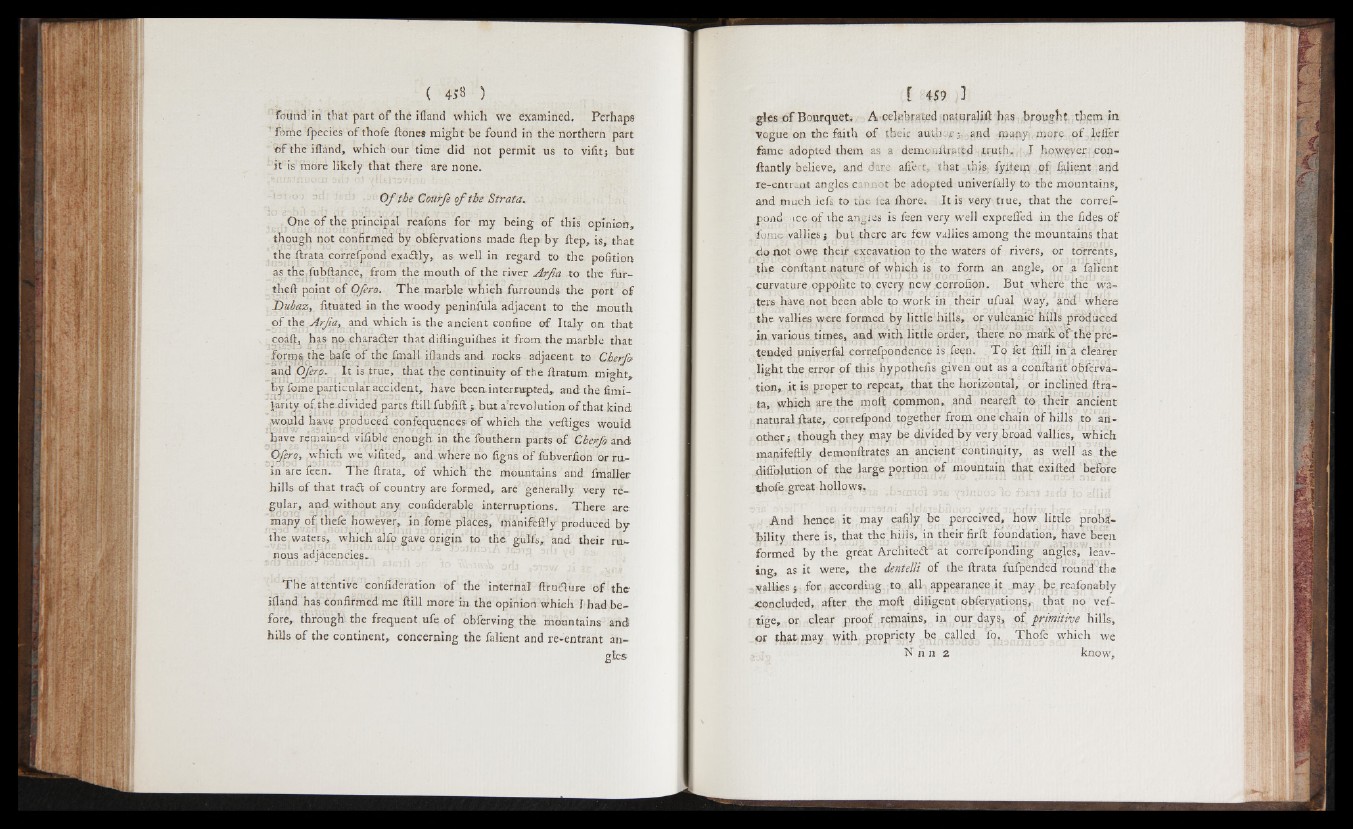
found in that part o f thé ¡(land which we examined. Perhaps
' foriie l)>ecies o f thofe ñones might be found in the northern part
o f the ifland, which our time did not permit us to vifit ; but
it is!more likely that there are none.
O f the Courfe o f the Strata.
One o f the principal reafons for my being o f this opinion,
though not confirmed by obfervations made ftep by ftep, is, that
the ñrata correfpond cxadtly, as well in regard to the pofition
as the fubftance, from the mouth o f the river A r fa to the fur-
theft point of Ofero. The marble which furrounds the port o f
Dubaz, fituated in the woody peniniula adjacent to the mouth
o f the Arjiet, and which is the ancient confine o f Italy oa that
coaij, has rw.charariter that diftingulfhes it from, the marble that
formsythe laafe o f the imall iflands and rocks- adjacent to Cherjb
and Ofero. It is true, that the continuity o f the ftratum might,
, -ÎIqme particulacaccident, have beenintermpted, antithefimi-
jarity of the divided parts ftilLfubfi.il ; but a'revolution of that kind
¡would have produced confequences o f which the veftiges would
have remained vifible enough in the fouthern parts o f Cberfo and
Ofero, which wé vifited, and where no figns of fubverfion or ruin
are feen. T hé ft rata, o f which' the moun tains and lrnaller
hills o f that traâ of country are formed, are generally very regular,
and without any confiderable interruptions.. There are
many oij thefe however, in feme places, manifeftly produced by
the'.waters, which alfp gave origin to the gulfs, and their ru-
nous adjacencies.
T h e attentive confïdèrattom o f the internal ftmdlure o f the
ifland has confirmed me ftill more in the opinion which 1 had before,
through the frequent ufe o f obferving the mountains and
hills o f the continent, concerning the falient and re-entrant angles
gles o f Bourqueti A celebrated naturalift has brought, them in
vogue on the faith o f their authors ¡and many, more o f leffer
fame adopted them as a demonftrattd truth- J however con-
ftantly believe, and dare affect, that this-, fyfiem o f iklient arid
re-entr.nt angles cannot be adopted univerfally to the mountains,
and much iefs to the lea ihore. It is very true, that the correfpond
ice o f the angles is feen very well expreffed in the fides o f
Iona, vallies -, but there arc few vallies among the mountains that
do not owe their excavation to the waters o f rivers, or torrents,
the confiant nature o f which is to form an angle, or a falient
curvature oppofite to. eyery nevy corrofion. But where the waters
have not been able to work in their ufual way, and where
the vallies were formed by little hills, or vulcanic hills produced
in various, times, and with little order, there no mark o f the pretended
qniyerfal correfpondence is feen. Tq fet ftill in‘a clearer
light the error of this hypothefis given out as a copftarif obfervi-
tion, it is proper to repeat, that the horizontal, or inclined ftra-
ta, which are the moft common, and neareft to their aricient
natural ftate, correfpond together from one chain o f hills to another
j though they may be divided by very broad vallies, which
manifeftly demonftrates an ancient continuity, as well as the
diflalution of the large portion o f mountain that exilled before
thofe great hollows.
And hence it may eafily be perceived, how little probability
there is, that the hills, in their firft foundation, have been
formed by the great Architedir àt correipondirig' angles, leaving,
as it were, the dentelli o f the ftrata fufpended round the
vailles i for according to all appearance it .may bereafonably
concluded, after the moil diligent obferyations,! that no vef-
tige, or clear proof remains, in our days, o f primitive hills,
or that may with propriety be called fo. Thofe which we
N a n 2 know,